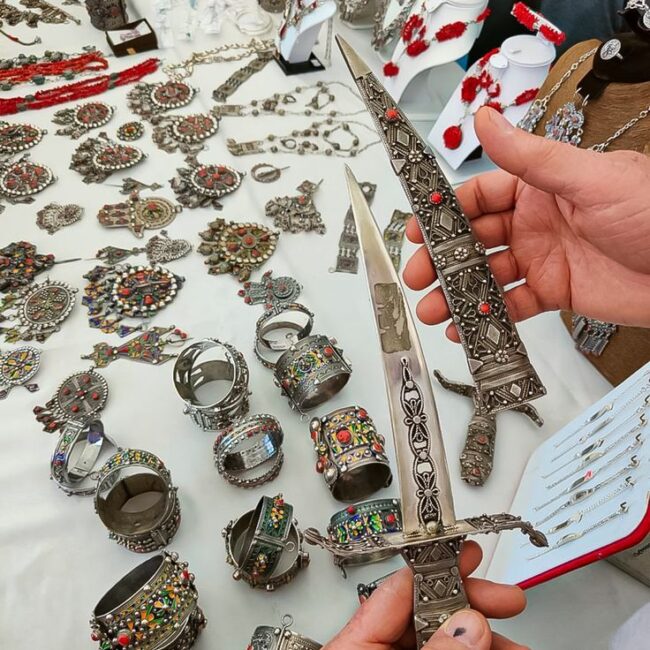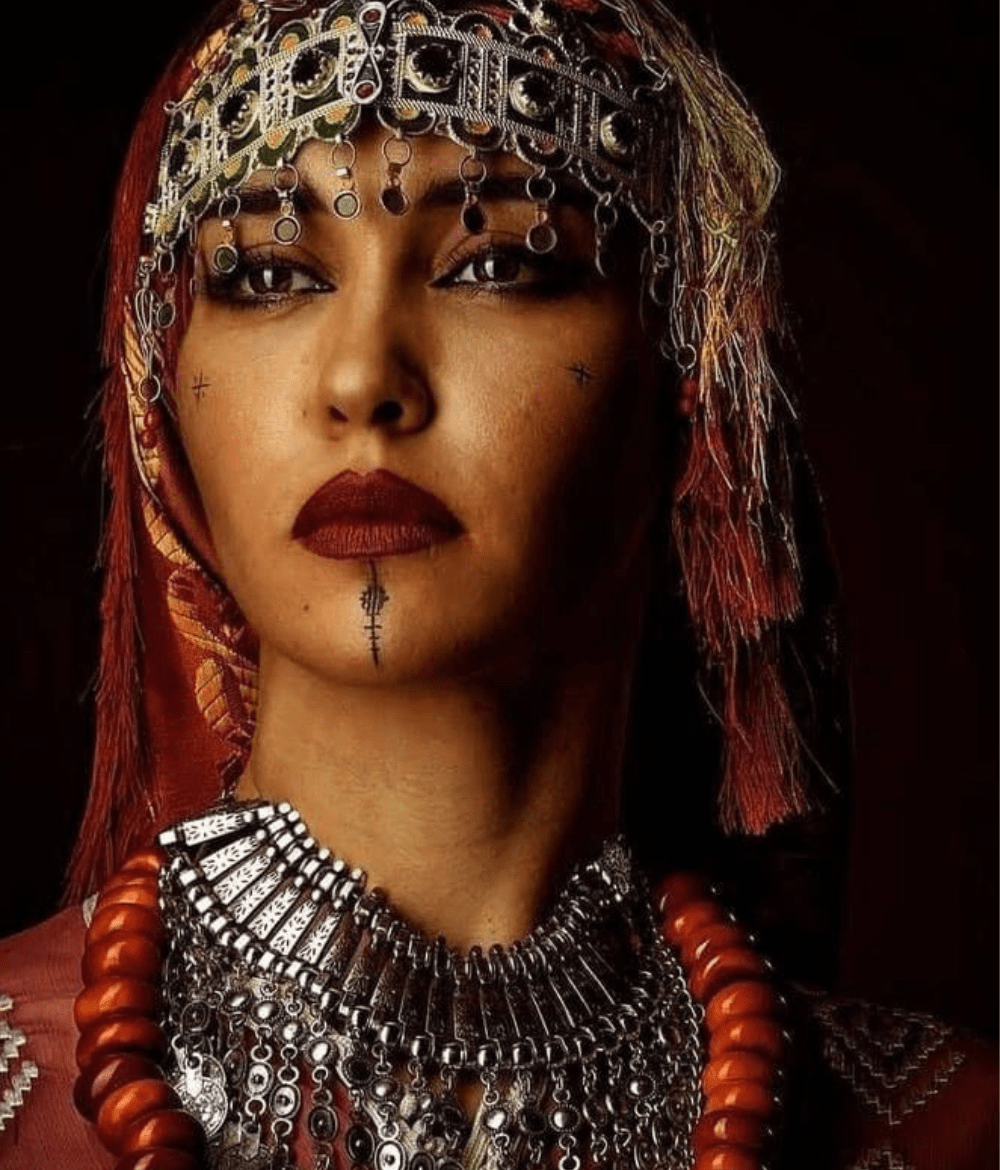The Rich History of Berber Jewelry: Symbols and Meanings
ⴰⵎⴽⴰⵏ ⵉ ⴷ ⴼⵓⵙ ⴷ ⵙⴻⴷⴷⵓⴽ, ⴰⴷ ⵉⴳ ⵉⵍⵍⴰⵏ ⵜⴰⴼⵓⴽⵜ.
Berber jewelry is more than just adornment; it’s a captivating tapestry of culture, identity, and history. Passed down through generations, these ornate pieces are deeply embedded in the traditions of the Amazigh people, also known as Berbers, an indigenous ethnic group of North Africa. From their striking designs to the symbolic meanings they carry, Berber jewelry stands as a testament to the artistic and cultural legacy of the Amazigh community.
Historical Origins of Berber Jewelry
The history of Berber jewelry dates back thousands of years, reflecting the Amazigh people’s interactions with various cultures, including the Phoenicians, Romans, Arabs, and Europeans. These exchanges enriched their craft, incorporating new techniques and materials while preserving their unique artistic essence.
Traditionally, Berber jewelry was handmade by skilled artisans, often from silver. While gold was also used, silver was considered purer and more spiritually significant. Jewelry-making became a vital expression of Amazigh identity, especially during times of cultural suppression. Each piece tells a story of resilience, adaptability, and pride in their heritage.
Materials and Craftsmanship
Silver
Silver has long been the preferred material for Berber jewelry. In Amazigh culture, silver is believed to have protective and purifying qualities. The metal’s connection to the moon and femininity makes it especially significant for women, who traditionally wore these pieces as symbols of their status and identity.
Gemstones and Enamel
Vividly colored gemstones like coral, amber, and turquoise often adorn Berber jewelry, adding vibrancy and meaning. Each stone has its own symbolism:
- Amber: Protection and healing properties.
- Turquoise: Good fortune and spiritual balance.
- Coral: Vitality and protection from the evil eye.
Enamel work, typically in red, blue, green, and yellow, is another hallmark of Berber jewelry. The intricate patterns created with enamel amplify the beauty and cultural significance of each piece.
Design Techniques
Berber artisans use techniques such as filigree (delicate metalwork), granulation (creating tiny beads), and repoussé (hammering metal from the reverse side) to craft their intricate designs. These methods have been passed down through generations, ensuring that the jewelry retains its traditional essence.

ⴰⵎⴽⴰⵏ ⵉ ⴷ ⴼⵓⵙ ⴷ ⵙⴻⴷⴷⵓⴽ, ⴰⴷ ⵉⴳ ⵉⵍⵍⴰⵏ ⵜⴰⴼⵓⴽⵜ.
Symbolism in Berber Jewelry
Every piece of Berber jewelry is a language of its own, carrying symbols that convey messages about the wearer’s identity, beliefs, and life journey. Some of the most common symbols include:
Geometric Patterns
- Triangles: Represent fertility and protection.
- Circles: Symbolize eternity and the cyclical nature of life.
- Squares: Associated with stability and balance.
Tifinagh Inscriptions
Some pieces feature inscriptions in Tifinagh, the Amazigh script. These inscriptions often carry blessings, prayers, or expressions of cultural pride.
The Hand of Fatima (Khamsa)
This widespread symbol, also known as the Hamsa, is believed to ward off the evil eye and bring blessings. In Berber culture, it represents protection and strength.
Animal and Plant Motifs
Berber jewelry frequently incorporates motifs inspired by nature. These designs may signify harmony with the environment or specific attributes such as strength, endurance, or growth.
Social and Cultural Significance
Marriage and Dowry
Berber jewelry plays a central role in marriage ceremonies. It often forms part of the bride’s dowry, showcasing the family’s wealth and status. Large necklaces, elaborate earrings, and ornate headdresses are common in bridal attire, symbolizing prosperity and fertility.
Identity and Status
The type, size, and intricacy of jewelry worn by an Amazigh woman can indicate her marital status, regional affiliation, and social standing. In some cases, specific designs are unique to certain tribes, serving as markers of cultural identity.
Spiritual Protection
Many Amazigh people believe that jewelry provides spiritual protection. Amulets and talismans embedded in the jewelry are thought to safeguard the wearer from harm, misfortune, and malevolent spirits.
Regional Variations
Berber jewelry varies across North Africa, reflecting the diversity of Amazigh tribes and their environments.
- Moroccan Atlas Mountains: Large, chunky pieces with enamel designs and bold geometric patterns.
- Tunisian and Libyan Jewelry: Delicate filigree work and more gold usage.
- Algerian Kabyle Jewelry: Colorful enamel and intricate patterns.
Each region has its distinct style, yet all share a common thread of symbolism and craftsmanship.


Modern Influence and Revival
In recent years, Berber jewelry has gained global recognition as a symbol of Amazigh heritage and a stunning example of traditional craftsmanship. Modern designers often draw inspiration from these ancient pieces, blending traditional techniques with contemporary styles.
For the Amazigh people, the revival of their jewelry is not just about fashion; it’s a reclamation of their identity and cultural pride. Events like Amazigh cultural festivals and workshops help preserve these traditions, ensuring that the artistry and meanings of Berber jewelry continue to thrive.
Berber jewelry is a shining testament to the Amazigh people’s rich history and enduring spirit. Its intricate designs, symbolic meanings, and cultural significance make it far more than mere ornamentation—it is a vibrant expression of identity, resilience, and artistry. Whether as a treasured heirloom or a modern interpretation, Berber jewelry continues to captivate hearts and tell the timeless story of the Amazigh people.


Leave a Reply